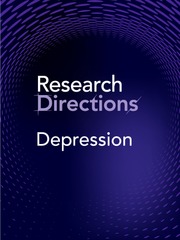Context
The potential relationships between traumatic experiences and the onset and course of major mood disorders have always been controversial. Some experiences, most notably physical or sexual abuse, as well as substantive bullying in childhood, are clearly recognised as major risk factors for a range of mental disorders, as well as a range of linked phenomena including self-harm and suicidal behaviours (McKay et al., Reference McKay, Cannon, Chambers, Conroy, Coughlan, Dodd, Healy, O’Donnell and Clarke2021; Zatti et al., Reference Zatti, Rosa, Barros, Valdivia, Calegaro, Freitas, Ceresér, Rocha, Bastos and Schuch2017). There is considerable interest and ongoing research into how these adverse experiences come to be ‘encoded’ via neurobiological or genetic mechanisms that then transmit those effects into later-onset major mental disorders, substance misuse or other self-harming behaviours (Maddox et al., Reference Maddox, Hartmann, Ross and Ressler2019).
In recent years, there has also been a renewed interest in the extent to which such very adverse childhood experiences are common (Mathews et al., Reference Mathews, Pacella, Scott, Finkelhor, Meinck, Higgins, Erskine, Thomas, Lawrence, Haslam, Malacova and Dunne2023), what specific forms of adverse experiences are most strongly linked to negative outcomes and what degrees of variations in childhood experiences are reported (retrospectively by adults) as being ‘traumatic’. Mental health services have moved to focus on ‘trauma-informed care’ as a central component of their engagement and treatment practices.
Globally, there is intense interest in the role that trauma may play on larger population groups – including most notably children and young people – who are exposed as a consequence of prolonged civil conflicts, war, violent crimes and associated major social disruptions. Where these experiences have been prolonged and cumulative, the inter-generational consequences may also be a major public health concern.
By contrast, there have also been concerns that the recent upsurge in traumatic explanations of the major mental disorders, including the full range of mood and psychotic disorders, is in danger of being overstated. The extent to which retrospectively reported major incidents of child abuse or neglect correspond to independent and contemporaneous reports of significant child abuse is limited. The broadening of the scope of retrospective reporting of emotional, physical or sexual maltreatment of children and youth is another factor for consideration in epidemiological and neuroscience studies of the topic.
Given the emphasis in most research is on reported exposure prior to or following the onset of major mood disorders, consideration also needs to be given to what individual or societal factors are influencing the changes in reporting of trauma by successive population-based cohorts (i.e., younger people, despite the societal factors that have promoted less exposure of children to abuse or neglect) or among emergency workers or war veterans exposed to highly variable experiences of traumatic or life-threatening events.
The fact that most people exposed to traumatic experiences do not go on to develop major mood or other psychiatric disorders argues that other individual, transgenerational or societal factors influence the prevalence of reporting traumatic experiences, the rate of exposure to these factors or the incidence of disorders that can be reasonably attributed to trauma.
New methods in genetic (e.g., Mendelian randomisation, epigenetics), neurobiological (e.g., longitudinal tracking of key stress-response systems, including the hypothalamic-pituitary-adrenal axis, immune and Sympathetic Nervous System) and brain imaging studies (e.g., longitudinal birth and youth cohorts) are now addressing many of these complex methodological challenges (Warrier et al., Reference Warrier, Kwong, Luo, Dalvie, Croft, Sallis, Baldwin, Munafò, Nievergelt, Grant, Burgess, Moore, Barzilay, McIntosh, van IJzendoorn and Cecil2021).
More informed answers to these questions are critical to deepening our understanding of the place of traumatic experiences within the risk to onset, illness course and response to treatment of those with depressive or other mood disorders. Additionally, they are also clearly important to developing appropriate population-health-based responses, while also assisting those individuals and those social groups that have been most affected by traumatic experiences,
How to contribute to this Question
If you believe you can contribute to answering this Question with your research outputs, find out how to submit them in the Instructions for authors (https://www.cambridge.org/core/journals/research-directions-depression/information/author-instructions/preparing-your-materials). This journal publishes Results, Analyses, Impact papers and additional content such as preprints and ‘grey literature’. Questions will be closed when the editors agree that enough has been published to answer the Question so before submitting, check if this is still an active Question. If it is closed, another relevant Question may be currently open, so do review all the open Questions in your field. For any further queries check the information pages (https://www.cambridge.org/core/journals/research-directions-depression/information) or contact this email ([email protected]).
Competing interests
IBH is the Co-Director of Health and Policy at the Brain and Mind Centre (BMC), University of Sydney, Australia. The BMC operates an early-intervention youth services at Camperdown under contract to Headspace. Professor Hickie has previously led community-based and pharmaceutical industry-supported (Wyeth, Eli Lily, Servier, Pfizer, AstraZeneca, Janssen Cilag) projects focused on the identification and better management of anxiety and depression. He is the Chief Scientific Advisor to, and a 3.2% equity shareholder in, InnoWell Pty Ltd which aims to transform mental health services through the use of innovative technologies.





